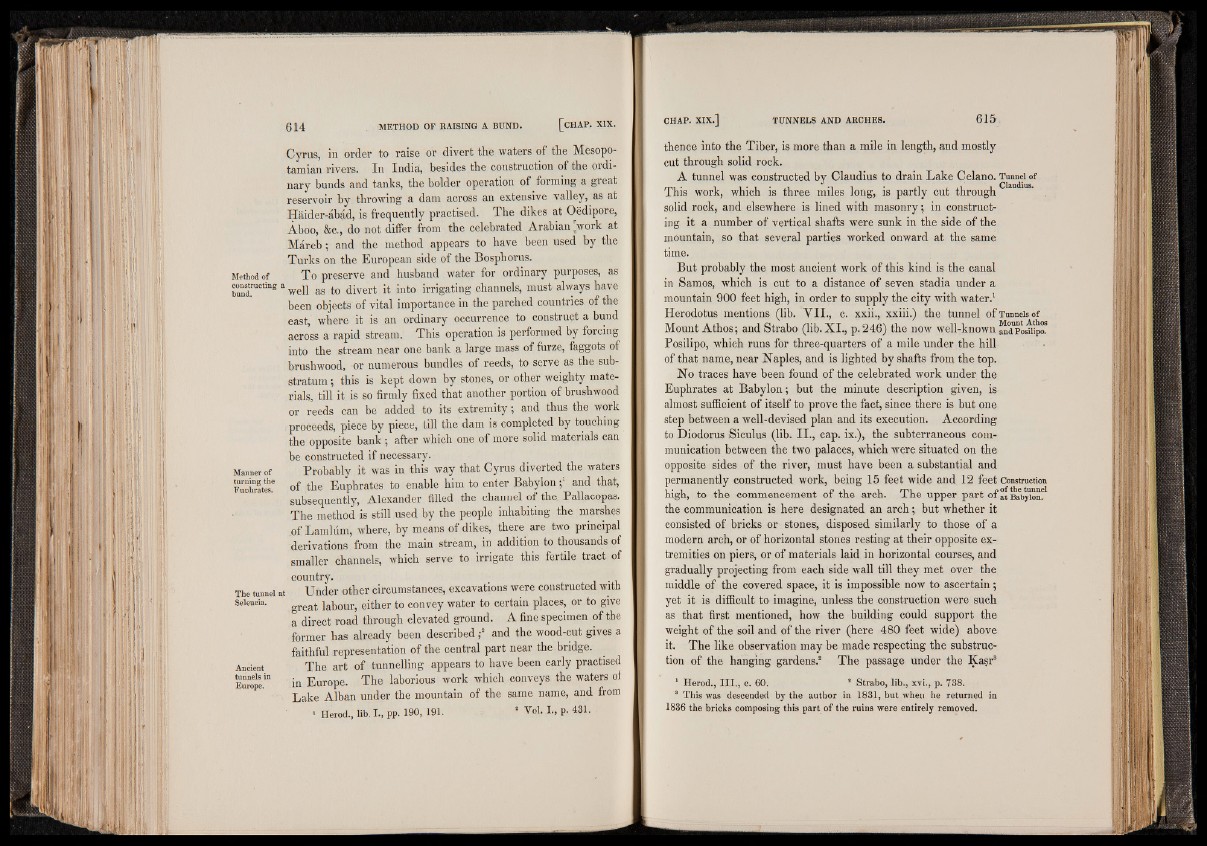
Cyrus, in order to raise or divert the waters of‘ the Mesopotamian
rivers. In India, besides the construction of the ordinary
bunds and tanks, the bolder operation of forming a great
reservoir by throwing a dam across an extensive valley, as at
Haider-abad, is frequently practised. The dikes at Oedipore,
Aboo, &c., do not differ from the celebrated Arabian swork at
Mareb; and the method appears to have been used by the
Turks on the European side of the Bosphorus.
Method of To preserve and husband water for ordinary purposes, as
co^ruotmgawell ag tQ diyert J into irrigat;ng channels, must always have
been objects of vital importance in the parched countries of the
east, where it is an ordinary occurrence to construct a bund
across a rapid stream. This operation is performed by forcing
into the stream near one bank a large mass of furze, faggots of
brushwood, or numerous bundles of reeds, to serve as the substratum
; this is kept down by stones, or other weighty materials,
till it is so firmly fixed that another portion of brushwood
or reeds can be added to its extremity; and thus the work
proceeds, piece by piece, till the dam is completed by touching
the opposite bank ; after which one of more solid materials can
be constructed if necessary.
Manner of Probably it was in this way that Cyrus diverted the waters
Fuobrates? of the Euphrates to enable him to enter Babylon | and that,
subsequently, Alexander filled the channel of the. Pallacopas.
The method is still used by the people inhabiting the marshes
of Lamlum, where, by means of dikes, there are two principal
derivations from the main stream, in addition to thousands of
smaller channels, which serve to irrigate this fertile tract of
country.
The e.m.1 at Under other circumstances, excavations were constructed with
Seieucia. at iabour) either to convey water to certain places, or to give
a direct road through elevated ground. A fine specimen of the
former has already been described;2 and the wood-cut gives a
faithful representation of the central part near the bridge.
Ancient The art of tunnelling appears to have been early practised
i | | jn EUTOpe. The laborious work which conveys the waters of
Lake Alban under the mountain of the same name, and from
! Herod., lib. H pp. 190, 191. 8 Vol. I., p. 431.
thence into the Tiber, is more than a mile in length, and mostly
cut through solid rock.
A tunnel was constructed by Claudius to drain Lake Celano. Tunnel of
This work, which is three miles long, is partly cut through ‘ .
solid rock, and elsewhere is lined with masonry; in constructing
it a number of vertical shafts were sunk in the side of the
mountain, so that several parties worked onward at the same
time.
But probably the most ancient work of this kind is the canal
in Samos, which is cut to a distance of seven stadia under a
mountain 900 feet high, in order to supply the city with water.1
Herodotus mentions (lib. VII., c. xxii., xxiii.) the tunnel of Tunnels of
Mount Athos; and Strabo (lib. XI., p. 246) the now well-known andPostiipa
Posilipo, which runs for three-quarters of a mile under the hill
of that name, near Naples, and is lighted by shafts from the top.
No traces have been found of the celebrated work under the
Euphrates at Babylon; but the minute description given, is
almost sufficient of itself to prove the fact, since there is but one
step between a well-devised plan and its execution. According
to Diodorus Siculus (lib. II., cap. ix.), the subterraneous communication
between the two palaces, which were situated on the
opposite sides of the river, must have been a substantial and
permanently constructed work, being 15 feet wide and 12 feet Construction
high, to the commencement of the arch. The upper part of at Babylon,
the communication is here designated an arch; but whether it
consisted of bricks or stones, disposed similarly to those of a
modern arch, or of horizontal stones resting at their opposite extremities
on piers, or of materials laid in horizontal courses, and
gradually projecting from each side wall till they met over the
middle of the covered space, it is impossible now to ascertain;
yet it is difficult to imagine, unless the construction were such
as that first mentioned, how the building could support the
weight of the soil and of the river (here 480 feet wide) above
it. The like observation may be made respecting the substruction
of the hanging gardens.2 The passage under the Kasr3
1 Herod., I I I ., c. 60. 8 Strabo, lib., xvi., p. 738.
8 This was descended by the author in 1831, but when he returned in
1836 the bricks composing this part of the ruins were entirely removed.